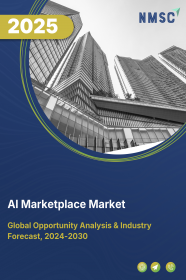
North America Data Center Market by Component (Hardware, Software, Service), by Type (Colocation, Hyperscale, Edge, Other Types), by Deployment Model (On-Premises, Cloud, Hybrid), by Tier Standard (Tier 1, Tier 2, Tier 3, Tier 4), by Energy Requirement & Power Density (Low Power, Medium Power, High Power), by Cooling Techniques (Air Cooling, Others), by Enterprise Size (Large Enterprises, Others), by End User (BFSI, Other End User)- Opportunity Analysis and Industry Forecast, 2024–2030
Industry: ICT & Media | Publish Date: 09-Apr-2025 | No of Pages: 243 | No. of Tables: 189 | No. of Figures: 114 | Format: PDF | Report Code : IC2431
US Tariff Impact on North America Data Center Market
Trump Tariffs Are Reshaping Global Business
North America Data Center Market Overview
The North America Data Center Market size was valued at USD 118.72 billion in 2023, and is predicted to reach USD 189.90 billion by 2030, at a CAGR of 6.9% from 2024 to 2030.
The data center, also recognized as the network infrastructure market, encompasses the planning, construction, operation, and maintenance of dedicated infrastructure for housing computing systems. It includes various elements such as servers, storage systems, and networking equipment, offering services such as cloud computing and connectivity solutions. Currently, the industry witnesses widespread adoption of cloud services, along with the emergence of edge computing to reduce latency.
Major trends include a focus on sustainability, heightened cybersecurity concerns, the integration of hybrid and multi-cloud approaches, and the impact of 5G networks. These trends highlight the industry's response to the increasing demand for scalable, efficient, and secure data processing and storage solutions in the era of digital transformation. According to the United States International Trade Commission, the data processing and storage market is expected to grow from USD 56 billion in 2020 to USD 90 billion by 2025.
Presence of Robust Data Center Infrastructure Boosts the Market Growth
In North America, particularly in the United States, the market growth landscape flourishes, boasting over 5,300 strategically positioned facilities across the nation. Northern California stands out as a notable hub for data-intensive enterprises, hosting major companies such as Google, Facebook, Uber, Twitter, and Yelp.
The distribution of the market across various jurisdictions mirrors the widespread integration of data in the US economy and the influence of cost-effective energy sources in specific regions. Remarkably, the top 10 locations of the market in the US collectively account for less than 40% of all the market, highlighting extensive geographic dispersion, with nearly every state hosting at least one center. Dominated by major players such as Lumen Technology, Verizon, Digital Realty, AT&T, and Equinix, industry in the US is largely consolidated, with these top five operators comprising 25.9% of total US market.
Substantial Investment by Tech Giants Propels the North America Data Center Market Growth
Reports indicate significant contributions to the US GDP by network infrastructure, with a PwC study commissioned by the Data Center Coalition revealing a USD 2.1 trillion boost between 2017 and 2021. Additionally, data intelligence firm CloudScene underscores the US's significant lead in the market numbers, hosting 5,389 facilities, a figure five times greater than the UK's 512 network infrastructures.
Furthermore, substantial investments by tech giants such as Amazon Web Services (AWS), demonstrated by a USD 35 billion allocation for new network infrastructure in Virginia, underscore the industry's growth trajectory and its vital role in supporting cloud expansion initiatives, even amidst broader corporate restructuring efforts.
High Initial Investment Hinders Market Growth
The data center market grapples with notable hurdles, prominently the high initial investment required and stringent environmental regulations. Establishing and maintaining network infrastructure demands significant upfront financial commitments, creating barriers for smaller businesses and startups. Additionally, compliance with environmental regulations necessitates ongoing investments in energy-efficient technologies hinders the overall North America data center market growth.
Integration of Edge Computing Presents Lucrative Opportunity for Market Expansion
The integration of edge computing into network infrastructure operations holds significant promise for the industry's future. By minimizing latency and enabling real-time processing, edge computing supports applications such as IoT and AR, easing the burden on centralized cloud data centers and offering scalability and flexibility.
This decentralized approach not only enhances security by processing sensitive data locally but also aligns with evolving digital landscapes, creating diverse opportunities for network infrastructure providers. Recent investments in startups such as Armada highlight the growing interest in edge computing solutions, reflecting a concerted effort to address connectivity challenges and bridge the digital divide.
The U.S. Dominates the North America Data Center Market Share
In the United States, the market landscape is characterized by strategic dispersion, boasting over 5,300 facilities spread nationwide. Northern California stands out as a nucleus for data-intensive enterprises, housing industry giants such as Google, Facebook, Uber, Twitter, and Yelp. This widespread distribution reflects the integration of data into various sectors of the US economy, driven by factors such as regional energy cost considerations.
Surprisingly, despite the prominence of key locations such as Northern California, the top 10 data center hubs collectively represent less than 40% of all US facilities, showcasing a remarkable geographic diversity where nearly every state hosts at least one network infrastructure. Moreover, market dominance is evident, with the industry largely controlled by major operators such as Lumen Technology, Verizon, Digital Realty, AT&T, and Equinix, who collectively command a significant portion of the market share.
Additionally, the market plays a pivotal role in bolstering the US economy, as highlighted by a PwC report commissioned by the Data Center Coalition (DCC), revealing a substantial contribution of USD 2.1 trillion to the GDP between 2017 and 2021. CloudScene, an Australian-based data intelligence firm, further underscores the nation's market supremacy, reporting a staggering 5,389 facilities, significantly surpassing the UK's count of 512.
Furthermore, the industry's growth trajectory is fueled by substantial investments from tech behemoths such as Amazon Web Services (AWS), exemplified by a USD 35 billion infusion into new Virginia-based network infrastructure. Despite broader corporate restructuring efforts, such investments underscore a steadfast commitment to cloud expansion, facilitating job creation and fortifying AWS's position in the ever-evolving cloud computing market.
Canada to Witness Substantial Growth in the North America Data Center Market
In Canada, companies are embracing digital transformation with fervor, aiming to streamline their operations effectively. Recent findings from the International Data Corporation (IDC) reveal that over 50% of Canadian businesses view application modernization as a top strategic priority.
This strategic endeavor involves the revamping and optimization of legacy applications to meet contemporary business needs and technological standards. Looking ahead, a staggering 75% of surveyed Canadian enterprises anticipate elevating application modernization to a critical strategic focus over the next two to three years.
This trend underscores the growing importance of data processing and analysis in the digital economy, as businesses strive to enhance efficiency, trim costs, and sharpen their competitive edge. Moreover, the North America data center market expansion has major companies within Canada.
Notably, Amazon Web Services (AWS) recently launched its second Canadian infrastructure region in Calgary, committing a substantial USD 17.9 billion investment. Similarly, Microsoft has invested USD 500 million to bolster its cloud computing presence in Quebec.
These substantial investments by leading tech entities are catalyzing advancements in Canada's market sector, contributing significantly to the nation's digital economy and innovation landscape. Additionally, Canada's stable economy, robust infrastructure, and favorable business environment make it an attractive destination for network infrastructure companies.
With 336 operational facilities across the country, Canada boasts the second-largest market presence in North America, underscoring its prominence in the industry. Major urban centers such as Toronto, Vancouver, and Montreal serve as pivotal hubs for the market establishments, further solidifying Canada's position as a key player in the global data economy.
Competitive Landscape
The key market players operating in the North America Data Center industry include Equinix, Digital Realty, CyrusOne, CoreSite, Iron Mountain, QTS Data Centers, Switch, Inc., EdgeConneX, Flexential, Vantage Data Centers, Amazon Web Services (AWS), IBM Cloud , Microsoft Azure, Oracle Cloud Infrastructure (OCI), Google Cloud Platform, 365 Data Centers, Cologix, Cyxtera , H5 Data Centers, Internap Holding LLC (INAP), and others.
North America Data Center Market Key Segments
By Component
-
Hardware
-
UPS
-
Generators
-
Transfer Switches
-
Cooling Systems
-
Computer Room Air Conditioning (CRAC)
-
Racks
-
Others
-
-
Software
-
Services
By Type
-
Colocation
-
Hyperscale
-
Edge
-
Other Types
By Deployment Model
-
On-Premises
-
Cloud
-
Hybrid
By Tier Standard
-
Tier 1
-
Tier 2
-
Tier 3
-
Tier 4
By Energy Requirement and Power Density
-
Low Power (Less than 20MW)
-
Medium Power (20-100MW)
-
High Power (100MW and More)
By Cooling Techniques
-
Air Cooling
-
Liquid Cooling
-
Dry Cooling
-
Immersion Cooling
-
Others
By Enterprise Size
-
Large Enterprises
-
Small and Medium Enterprises
By End User
-
BFSI
-
IT and Telecom
-
Government
-
Energy and Utilities
-
Other End Users
By Country
-
The U.S.
-
Canada
-
Mexico
Key Players
-
Equinix
-
Digital Realty
-
CyrusOne
-
CoreSite
-
Iron Mountain
-
QTS Data Centers
-
Switch, Inc.
-
EdgeConneX
-
Flexential
-
Vantage Data Centers
-
Amazon Web Services (AWS)
-
IBM Cloud
-
Microsoft Azure
-
Oracle Cloud Infrastructure (OCI)
-
Google Cloud Platform
-
365 Data Centers
-
Cologix
-
Cyxtera
-
H5 Data Centers
-
Internap Holding LLC (INAP)
REPORT SCOPE AND SEGMENTATION:
|
Parameters |
Details |
|
Market Size in 2023 |
USD 118.72 Billion |
|
Revenue Forecast in 2030 |
USD 189.90 Billion |
|
Growth Rate |
CAGR of 6.9% from 2024 to 2030 |
|
Analysis Period |
2023–2030 |
|
Base Year Considered |
2023 |
|
Forecast Period |
2024–2030 |
|
Market Size Estimation |
Billion (USD) |
|
Growth Factors |
|
|
Countries Covered |
3 |
|
Companies Profiled |
20 |
|
Market Share |
Available for 10 companies |
|
Customization Scope |
Free customization (equivalent up to 80 working hours of analysts) after purchase. Addition or alteration to country, regional, and segment scope. |
|
Pricing and Purchase Options |
Avail customized purchase options to meet your exact research needs. |

















 Speak to Our Analyst
Speak to Our Analyst





















